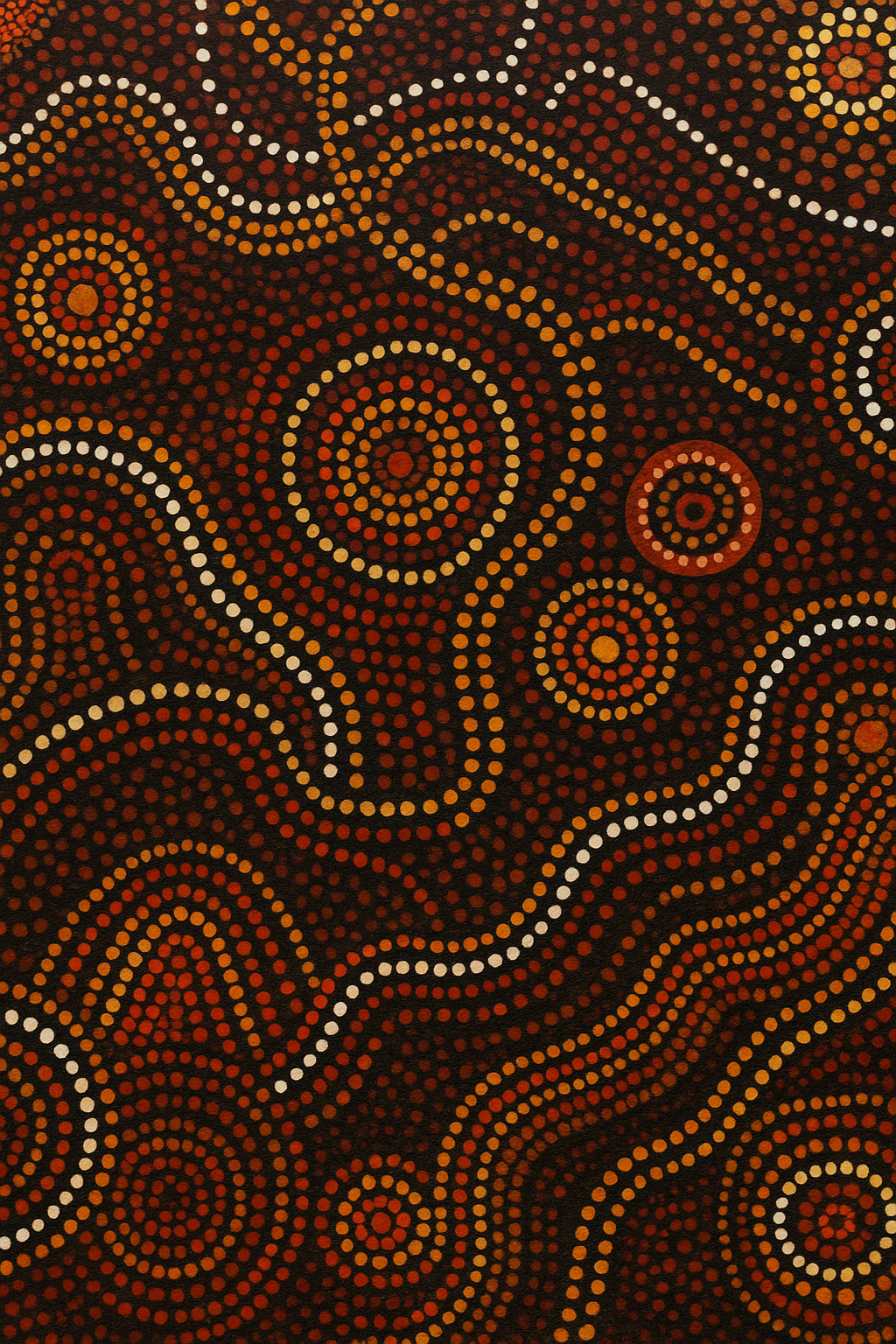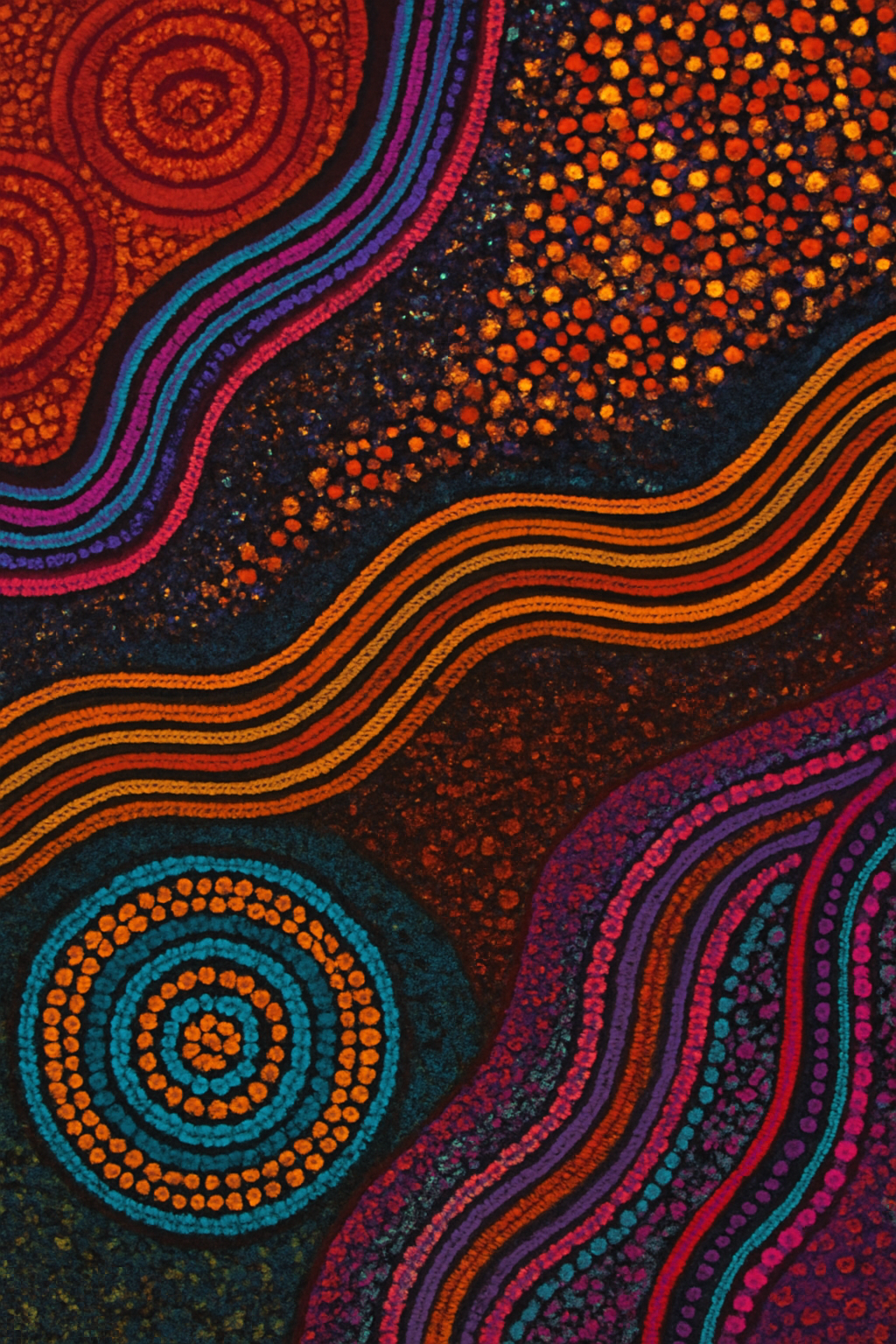-
Dreamtime (the Dreaming) is a living cultural reality, not a myth; it connects past, present, and future.
-
Aboriginal artworks carry specific stories, permissions, and responsibilities linked to Country, kinship, and ceremony.
-
Ethical collecting means seeking authentic provenance, fair payment/royalties, and cultural transparency.
-
Understanding regional styles, symbols, and story rights deepens appreciation and supports respectful collecting.
What Are Dreamtime Stories? A Cultural Foundation
For tens of thousands of years, First Nations peoples across Australia have carried knowledge, law, and identity through story. Often called Dreamtime or the Dreaming, these are not “legends” in a Western sense. The Dreaming refers to ancestral beings whose actions shaped the land, rivers, sandhills, waterholes, ranges, and who established ceremony, kinship, and responsibilities that continue today. The Dreaming is timeless: simultaneously origin, presence, and future continuity.
For an art collector, this matters profoundly. When you view an artwork informed by Dreaming, you are encountering a living cultural narrative. The painting is not simply aesthetic; it is a visual record of belonging, shared with permission and carried through an artist’s cultural authority.
How Dreamtime Shapes Aboriginal Art
Art is a vital teaching and memory system. Symbols, palettes, and compositions encode story and place so they can be transmitted with respect. Common conventions include:
-
Concentric circles: meeting or ceremonial places, waterholes, camps.
-
U-shapes: people seated on the Country.
-
Curved and straight lines: travel routes, songlines, ancestral paths.
-
Animal/plant motifs: totems, food sources, seasonal change.
Crucially, artists paint what they have the right to paint, stories held through family lines, language groups, and Country. Cultural permission is not optional; it is central to authenticity. This is why two works with similar motifs can carry very different meanings based on the artist’s Country, lineage, and ceremonial role.
Dreamtime in Modern Painting
Contemporary Indigenous practice spans mediums and styles, while maintaining cultural integrity:
-
Dot painting (Western Desert): layers of dots can both reveal and respectfully veil sacred knowledge from uninitiated viewers.
-
Aerial perspectives: sweeping compositions map Country, creeks, sandhills, fire scars, yam trails, “seen from above.”
-
Ceremonial patterning: Awelye (women’s body paint), clan designs, or clan-specific cross-hatching appear with the relevant permissions.
-
Mixed media & colour: artists may use ochres, acrylics, or experimental textures to express seasonal change, ceremony, and storylines.
This visual language is not abstract expressionism for its own sake; it is cultural cartography—a mapping of Country, memory, and responsibility.
Australia’s Living Connection to the Dreaming
Dreamtime stories are woven into Australia’s identity. Sacred geographies—such as ranges, rock formations, and desert water systems, are chapters of the Dreaming. Across communities, cultural revival and recognition have strengthened public understanding: museums, schools, galleries, and cultural centres increasingly foreground First Nations knowledge.
For many collectors (in Australia and internationally), learning about the Dreaming deepens a sense of place. Art becomes a bridge, a way to encounter Country ethically, listen to Elders’ guidance, and appreciate how story and land are inseparable.
What Every Collector Should Know (Ethics, Provenance, and Respect)
1) Cultural transparency
Seek context with each work:
-
Artist’s name, language group, and community/region
-
The story and its connection to Country
-
A note that the artist holds permission to depict that story
2) Authenticity & provenance
Request a Certificate of Authenticity (COA), detailed provenance, and where applicable, documentation from the relevant art centre or gallery. Ask how authenticity is verified (e.g., direct sourcing, long-term relationships, or alignment with recognised industry practices).
3) Fair payment and royalties
Ethical galleries disclose how artists are paid and whether artist resale royalties apply under relevant schemes. This ensures ongoing benefit to artists and estates.
4) Respecting cultural protocols
Some knowledge is not public. Accept that certain meanings will remain with custodians and that not all questions can or should be answered.
5) Clear buying process
A collector-friendly gallery explains shipping, insurance, taxes, international handling, and after-sales documentation. For international clients, clarity around export paperwork and artwork care matters.
Regional Styles & Reading the Work
While no brief list can capture the diversity of First Nations art, collectors benefit from a regional lens:
-
Central/Western Desert: layered dotting, aerial mappings, sandhill forms, Yam Dreaming, Tingari storylines.
-
Kimberley & East Kimberley: bold line-work, rarrk-like infill in some traditions, strong geological presence.
-
Tiwi Islands: combed lines, geometric forms, ochre palettes; ceremonial patterning.
-
Top End/Arnhem Land: cross-hatching (rarrk) and figurative ancestral beings on bark or board, with precise clan designs.
When browsing, pair visual reading with story notes and regional context. Over time, your eye will recognise Country-specific signatures the subtle ways artists show water courses, rock formations, ceremonial grounds, and seasonal change.
Why Dreamtime Art Attracts Collectors Worldwide
Cultural depth: Each work emerges from millennia of story, making it more than an object, it is a vessel of knowledge.
Symbolic storytelling: Motifs create an immediate emotional connection that differs from Western abstraction.
Aesthetic harmony: Earth-derived palettes and rhythmic structures integrate beautifully with contemporary interiors, while still holding cultural weight.
Legacy & responsibility: Many collectors value stewardship, living with art that honours Elders, supports artists, and keeps stories strong.
The Emotional Power of Dreamtime Art
Collectors often describe an artwork as alive, vibrant, grounding, and quietly resonant. That response is not accidental. Works carry the energy of Country and the continuity of story:
-
Dreamtime paintings carry memory.
-
Dreamtime paintings carry place.
-
Dreamtime paintings carry identity.
To live with such a work is to welcome care to display it respectfully, keep documentation, and remain open to learning.
Collecting With Understanding
-
Learn first, buy second. Read the story notes. Ask about the artist’s Country and permissions.
-
Work with ethical galleries. Look for transparent sourcing, clear provenance, and fair artist payment.
-
Document everything. Keep the COA, invoices, story statements, exhibition history, and condition reports together.
-
Consider conservation. Ask about ideal lighting, humidity, framing/stretching, and safe transport, especially for ochres or bark.
-
Embrace ongoing learning. Revisit artist pages, read interviews, and explore cultural resources. Respect grows with knowledge.
FAQs
1. What is Dreamtime in Aboriginal culture?
Dreamtime, or “The Dreaming,” refers to the spiritual and ancestral time when Aboriginal peoples believe the world was created. It’s not a past myth but an ongoing connection between people, land, and ancestors.
2. Why is understanding Dreamtime important when collecting Aboriginal art?
Because each artwork often depicts Dreamtime stories, understanding them adds depth, meaning, and respect for the artist’s cultural heritage.
3. How can I ensure the Aboriginal art I buy is authentic?
Purchase from reputable galleries like Red Desert Dreamings, which work directly with artists and communities to guarantee authenticity and ethical sourcing.
4. What makes Aboriginal art different from other art forms?
Aboriginal art is rooted in ancient storytelling traditions and deep spiritual ties to the land, making every piece more than just visual—it’s a living narrative.
Internal Pathways for Deeper Learning
To make your collecting journey easier (and culturally aware), look for or request:
-
Artist pages that include language group, community, story permissions, and quotes in the artist’s own words.
-
A Buying Guide explaining end-to-end logistics (shipping Australia-wide/internationally, insurance, customs, and export).
-
A simple Provenance & Authenticity explainer with a sample COA layout.
-
A Region Map or overview linking artworks to Central/Western Desert, the Kimberley, Tiwi, and Arnhem Land.
-
Responsible Terminology: consistent use of “Dreaming,” “Country,” “Elders,” and “language group” throughout your reading and notes.
Collecting With Understanding
Dreamtime art is a gift of continuity. It does not ask us merely to look, it asks us to listen: to Country, to Elders, to the quiet discipline of story. For collectors, respectful engagement transforms a purchase into stewardship. Learn the story, honour the artist and community, keep the provenance strong, and let the work teach you again and again about connection.
We acknowledge the Traditional Owners of the lands on which these stories are shared and we honour their Elders, past and present. We pay respect to artists, families, and communities who continue to care for Country and keep culture strong.
Dreamtime stories remain one of humanity’s most profound cultural inheritances. Through art, these stories continue to be shared with integrity and respect. Collectors who take the time to understand the meaning behind each piece experience something far deeper than visual appreciation, they experience connection, story, and continuity.
Discover authentic Dreamtime artworks and hear the stories behind each piece.







